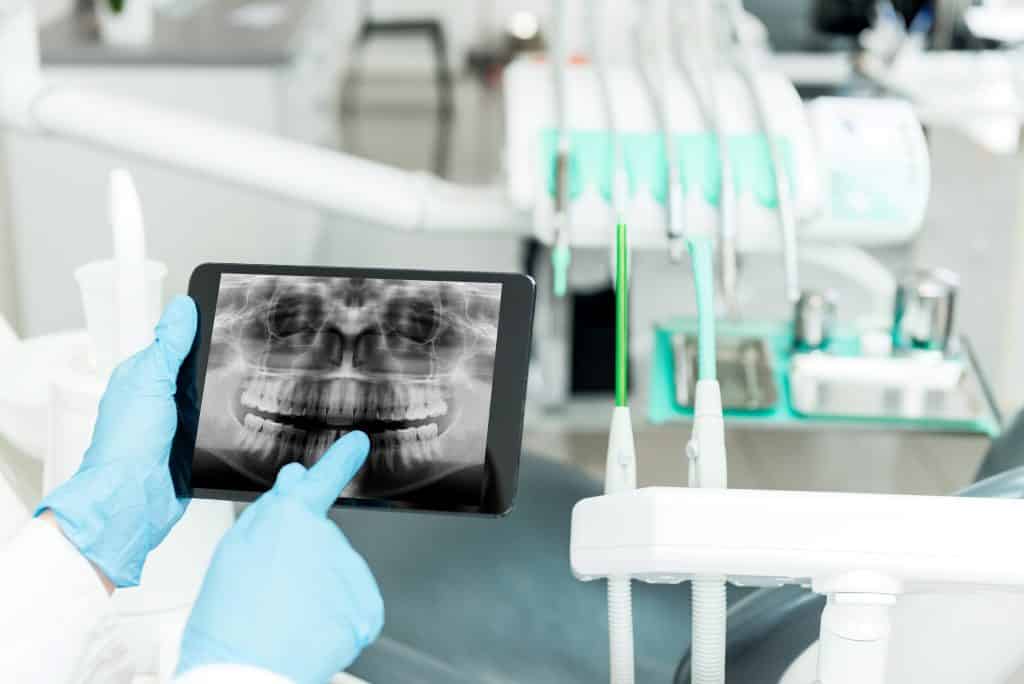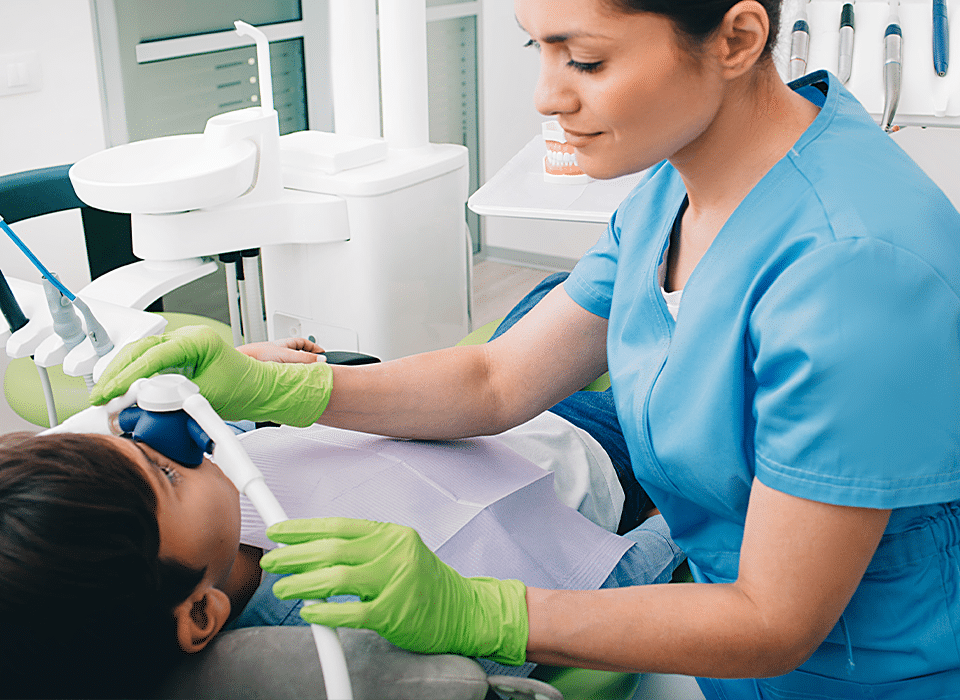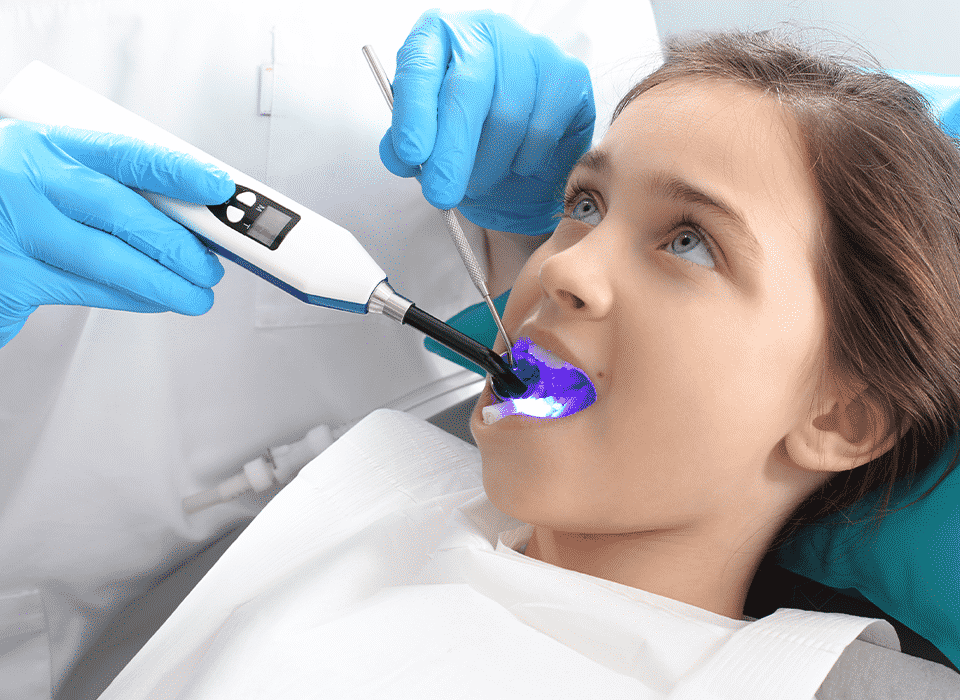Pediatric dentistry differs from adult dentistry in many ways. Children’s teeth are growing quickly and come in more frequently than adults, which means that they can lose a lot of teeth if not taken care of properly. As early as possible, it is important to have your child on a regular schedule with visits to our office every six months for cleanings and checkups. We will be able to monitor the development of your child’s teeth and gums and catch any problems early.
Age One Visit
A child’s first visit should occur at one year or when the first tooth erupts. The first time our child has a checkup, we will determine the best treatment plan for your child. It is important to take care of your child’s teeth early to avoid cavities and other dental problems as they get older.
Erupting Teeth
A child’s teeth do not come in all at once. Instead, they erupt over several years. Generally, the first tooth will emerge between six and twelve months. At this point, it is important to start examining your child’s mouth every day. Once a tooth erupts, the surrounding teeth begin to move and erupt. It is important to clean your child’s teeth and gums daily to prevent discomfort.
Your Baby’s Hygiene Routine
It is important to get your baby used to a hygiene routine when they erupt their first tooth as a parent. This is also when you should be downloading every important information about your child’s teeth and routine for the future. This includes how to brush and floss properly, how to use fluoridated toothpaste wisely, as well as how to avoid common dental problems. We recommend a manual toothbrush with soft bristles for a child’s first tooth.
Routine Dental Check-Ups
Like adults, routine checkups are important to keep your child’s teeth healthy. We recommend doing teeth cleaning every six months. This is a great time to check and ensure your child’s teeth are not getting cavities or other dental problems. We will start a treatment plan to keep your child’s teeth healthy if we notice any problems.
Your infant needs daily supervision to keep their teeth free from dental problems. We recommend that you visit us regularly for checkups so we can help monitor your child’s development.
Cleaning Your Baby’s Gums
Infants have gums that are much softer than adults. This is because their teeth are still developing, and they do not have the strength to hold back the eruption of teeth. It is important to keep your infant’s gums moist and clean to help them develop healthy teeth for the future. Water and a gentle dump cloth are a good way to keep your infant’s gums clean during their first year. Wrap the cloth around your finger and gently and softly clean the gum area of their teeth.
The First Tooth
When your child is about a 6 months old, their first tooth will begin to erupt. The first tooth to erupt is often the bottom front tooth. At this point, we recommend using a soft-bristled toothbrush to clean your infant’s teeth regularly. Keep in mind that some medication might have side effects like dry mouth. To prevent this, you need to keep your infant’s mouth moist so that they can develop healthy teeth and gums as they grow older.
More Teeth
The next teeth to erupt are the uppers, and then the lowers. They come in at different times and create a little gap as they move into place. We recommend using a soft-bristled toothbrush like an infant brush, which is specifically designed for your child. These brushes are small so that you can easily reach their back molars and clean them properly.
Avoiding Cavities
Infants are more prone to dentist cavities because their teeth are softer. If you have a bottle-feeding baby, it is important to make sure your child’s teeth remain free from cavities as they get older. Frequency of sugar during the day is what causes cavities. It is important to control milk, juices only with meals and water (tap water / fluoridated). It is best to clean their gums and teeth regularly during the day to avoid cavities while they are young.
At Smiling With Love Pediatric Dentistry, we will help you restore your child’s smile. The restorative process is done with your child in mind to make sure they are comfortable and understand the process. Our pediatric dentist will work with you to determine the best treatment for your child. Here are some procedures we can recommend:
Tooth-Colored Fillings
Your child’s permanent teeth are often in need of some dental work. If you have noticed that your child has a chip or missing tooth, we can help provide you with a tooth-colored filling to fill in the gap. This will make it easier for them to chew and eat food as they get older. We use a material called resin bonding to help restore your child’s smile. It is also a great option for putting a temporary filling in your child’s tooth.
Stainless Steal Crown (SSC)
After a baby root canal, or if there is substantial damage to a rear baby tooth from cavities or trauma, a Stainless Steel or White Zirconia Crown may be advised for your kid. When a traditional filling is deemed insufficient to safeguard the tooth until it falls out naturally, they are recommended. (Remember that baby molars don’t fall out until you’re 11-14 years old.) The distinction between stainless steel and white crowns is primarily cosmetic, but the advantages and disadvantages of each crown can be explored with your child’s doctor before it is placed.
Your baby will naturally want to suck on fingers and toys. It is their way of gaining pleasure and connecting with people around them. While this helps during the baby stage, you need to find ways to help encourage your child to stop when they are older.
Are these habits bad for teeth?
The improper use of fingers and toys can harm your child’s teeth. If they suck on their fingers too much, they could end up with a cross-bite or an open bite. This is when the upper teeth bite down into the lower teeth rather than coming together in front. You will also notice that your child’s back teeth are getting crowded or pushed forward. This is because your child has been using their fingers for most of their life, and the permanent teeth are getting pushed forward to make room. This can cause a lack of space for their permanent teeth, which can cause dental problems in the future.
When does it become a problem?
You will notice a problem when your child is starting to bite a lot and their permanent teeth are coming in. At the young age of 18 months, you should start noticing how they are eating and if their teeth are emerging properly. You will also notice if your child is experiencing issues with eating and chewing food properly, which can signify that the teeth are not developing properly.
Gum Disease is an oral health condition that starts as early as age two. It begins with inflammation of the gums, which causes irritation and loosening of the teeth. This will eventually weaken the teeth, allowing decay and infection to spread through the mouth. While it is common, it can cause serious complications in the future. Preventing gum disease can help your child’s health and teeth. It will also give them a healthy smile as they grow older.
What are the symptoms of gum disease?
- Smooth and shiny gums
- Sore or bleeding gums when brushing
- Bad breath
- Gums that pull away from the teeth
- Loosening of teeth
Prevention is key!
- Check the back of your child’s mouth daily to look for any bleeding. If you find any red areas, do not hesitate to contact our experienced dentist as soon as possible.
- We recommend having your child brush immediately after every meal and at least twice per day with a toothbrush with a soft bristle for extra help in cleaning their teeth and gums.
- We recommend flossing once per day.
- Encourage your child to drink milk and eat other dairy products at least three times per day, as it will provide them with calcium that the teeth need to stay healthy and strong.
- Limit your child’s sugar intake as much as possible.
- Have your child see our dentist every six months for regular cleanings and checkups.
Treatment
There is an option for your child to receive deep cleaning along with cosmetic dentistry if necessary. This will help restore their smile and eliminate any pain they are experiencing. The cleaning is done using a special tool called a scaler that acts as a toothbrush and gently cleans the teeth. If you notice any sensitivity after the cleaning, we recommend rinsing the mouth out with a solution called chlorhexidine gluconate to help.
As a parent, you should be aware of any risk factors that could cause your child to experience tooth grinding. Tooth grinding, also known as bruxism, is a condition of excessive teeth grinding at night. This can cause discoloration or problems with the jaw bone. It would help if you were wary of this problem because it could lead to other oral health problems and bad habits in the future.
Causes of Bruxism
- Misaligned teeth: The teeth can become misaligned easily if they are not growing at the proper rate.
- Medical conditions: Medical conditions can cause pain and inflammation, which in turn can cause your child to grind their teeth at night.
- Anxiety and stress: Stress and anxiety can cause the jaw muscles to tense, leading to excessive teeth grinding at night.
- Teething: Teething can cause teeth to grind because of the constant pain they feel while developing teeth.
- Habits: Your child may be grinding their teeth as a habit, which can increase the risk of other oral problems or decay.
Grinding teeth is a habit that your child will grow out of most of the time.
So what should you do if your child grinds their teeth?
The first thing to do is monitor your child and see if they exhibit nighttime grinding habits. If so, you should seek out a dentist as soon as possible. The team at our dental office will help with any further treatment.
Coming Soon

In cases where a tooth is severely decayed, fractured, or weakened, dental crowns may be necessary to restore its function and appearance. At North Shore Smiles Pediatric Dentistry, we offer both stainless steel crowns (SSC) and white zirconia crowns. Stainless steel crowns are commonly used for primary teeth due to their durability and cost-effectiveness. Stainless steel crowns (SSC) are particularly suitable for posterior teeth and molars. They provide excellent protection and strength for teeth that have extensive decay or are at risk of further damage. SSCs are pre-formed and custom-fitted to your child’s tooth, ensuring a precise and comfortable fit.
In addition to stainless steel crowns, we also offer white zirconia crowns as an aesthetic alternative for visible front teeth. These crowns are made from a strong, tooth-colored ceramic material that closely resembles the natural appearance of the tooth. White zirconia crowns are highly durable and provide an excellent long-term solution for restoring the function and beauty of your child’s smile.

Regular dental cleanings are essential for maintaining optimal oral health in children. A thorough cleaning removes plaque and tartar buildup from your child’s teeth. We use specialized instruments and gentle techniques to ensure a comfortable experience. In addition to cleaning, we also educate your child on proper brushing and flossing techniques, emphasizing the importance of maintaining good oral hygiene habits at home. By promoting regular cleanings and effective oral care practices, we aim to prevent cavities, gum disease, and other oral health issues.

Fluoride is a naturally occurring mineral that strengthens tooth enamel, making it more resistant to acid attacks from plaque bacteria and sugars. Our fluoride treatments are tailored to your child’s specific needs. We assess their risk of developing cavities and determine the appropriate fluoride concentration for their age and oral health. The treatment involves the application of a fluoride-rich gel, varnish, or foam to the teeth. It is quick, painless, and highly effective in preventing tooth decay. By incorporating fluoride treatment into your child’s dental care routine we can significantly enhance their oral health and reduce the risk of cavities.

When treating cavities or tooth fractures, we use tooth-colored fillings to restore the damaged teeth. These composite resin fillings are carefully matched to the natural color of your child’s teeth, providing a seamless and aesthetically pleasing result. Unlike traditional silver amalgam fillings, tooth-colored fillings are metal-free and contain no mercury. They bond directly to the tooth structure, creating a strong and durable restoration that preserves the natural appearance of the tooth. Additionally, tooth-colored fillings require less tooth structure removal, allowing for a more conservative treatment approach.

Baby teeth usually stay in place until “pushed out” by a permanent tooth that takes it’s place. Unfortunately, some children lose baby teeth too early. This can cause problems so it becomes necessary to use a space maintainer. A space maintainer is a device that saves room in the mouth for the adult teeth when the baby teeth come out too early. Ideally, baby teeth should be preserved until the adult teeth push them out naturally. Baby teeth are important for a child to eat comfortably and also to save space for the adult teeth. When they must be removed due to cavities or injury, a space maintainer becomes necessary.
The procedure to make a band and loop space maintainer is relatively simple. A mold of the child’s mouth is taken and then the laboratory makes the space maintainer, which consists of two parts. There is a band that fits around the tooth behind the missing one, and a loop or brace that goes over the gum where the missing tooth was and then rests against a tooth in front of it. When the band is cemented on the tooth, it prevents the teeth from moving into the space where the missing tooth was, and allows the adult tooth enough space to grow into the proper position. The space maintainer should then be evaluated by our doctor, they can do this at every check-up appointment and he will remove them when the adult teeth are visible and have poked through the gum.

Your children deserve straight and healthy teeth. That’s why Interceptive Orthodontics is an important part of early dental care for young children. With interceptive orthodontics, The doctor is able to identify and treat problems that left untreated at this stage may require more extensive treatment if postponed until a later date.
Interceptive Orthodontics identifies children’s teeth that are coming in crooked or crowded usually by the age of 7. If early treatment is indicated, the doctor can provide pediatric dental treatment to begin correcting problems this can reduce the time and sometimes eliminate the need for braces later on. In the past corrective dentistry was not used until the age of 10 to 12 years of age and involved braces.
By age 7, most children have a mix of baby (primary) and adult (permanent) teeth so now is the best time with to begin to correct problems such as dental crowding, too much space between teeth, protruding teeth and extra or missing teeth and sometimes jaw growth problems.
A bad bite develops over time and left untreated until later in life typically requires more extensive dental work. The causes can be any number of things thumb- or finger-sucking, mouth-breathing, dental disease, abnormal swallowing, poor dental hygiene, the early or late loss of baby teeth, accidents or poor nutrition. Whatever the cause, The doctor is usually able to treat most conditions successfully.
Why see an Pediatric Dentist?
Pediatric Dentists like ours are trained to spot subtle problems with jaw growth and emerging teeth while some baby teeth are still present. The advantage for patients of early detection of orthodontic problems is that some problems may be easier to correct if they are found and treated early. Waiting until all the permanent teeth have come in, or until facial growth is nearly complete, may make correction of some problems more difficult. In some cases even if a problem is detected, our doctor will take a “wait-and-see” approach, and check your child regularly as the permanent teeth come in and the jaws and face continue to grow. Our doctor, will know when the ideal time for her to begin dental treatment is necessary to ensure the best results. Our doctor’s goal is to provide each child with the most appropriate treatment at the most appropriate time.
Benefits of early treatment
In some cases, The doctor might find something that can benefit from early treatment. Early treatment may prevent more serious problems from developing and may make treatment at a later age shorter and less complicated. Some earlier treatable conditions include:
- Guide jaw growth
- Lower the risk of trauma to protruded front teeth
- Correct harmful oral habits
- Improve appearance and self-esteem

At North Shore Smiles Pediatric Dentistry, we utilize the latest digital X-ray technology to capture highly detailed images of your child’s teeth and jaws. Our digital X-ray system offers several advantages over traditional film X-rays. It significantly reduces radiation exposure, making it safer for children. Additionally, the digital images are instantly available, allowing us to diagnose dental conditions more efficiently. With enhanced image quality and the ability to magnify and manipulate the images, we can accurately detect dental issues such as cavities, impacted teeth, and bone abnormalities, enabling us to provide precise treatment recommendations.

Pain Prevention
Pain prevention should be managed a bit differently for children. Depending upon the parent’s preference, the age and health of the child, and the dentist’s comfort level, a general anesthesia may be used for a child who is receiving a tooth extraction. A topical numbing ointment will most certainly be used, often tasting of bubble gum or some such flavor. A shot may also be given as well. If the child is not frightened of the dentist or the procedure, they are more likely to be excited about their upcoming tooth fairy visit, than to be worried about the pain. It is always better to use as few painkillers as possible on children, while paying close attention to making certain that they are not suffering.
Procedure
After applying whatever numbing agents have been chosen, the dentist will use an elevator to wedge between the tooth and the bone surrounding it. This expands the tooth’s socket and separates its ligament. The extraction forceps will then be used, manipulating the tooth from side to side and rotating it for further socket expansion and ligament separation. When properly prepared this way, the tooth will be pulled upon to slide out of the socket in its entirety.
After Care
Bleeding is typical after a tooth has been extracted. This may last for only about a day. A small piece of gauze will be applied to the area of the tooth extraction. This should be kept in place for long enough for the blood to clot. It is important for the child’s mouth to be kept as clean as possible during the healing period. This can be done by rinsing the mouth with salt water several times per day. If any additional swelling occurs or if the child begins to feel additionally ill or comes down with a fever, then be certain to call the dentist immediately in case of infection. This rarely happens though. Children’s Tylenol or Ibuprofen should be purchased if the dentist did not already prescribe a painkiller for your child to increase their comfort after the extraction is complete. It is often best if these not be used until the blood clot has formed. It may be good to apply a bag of ice to the outside of the child’s jaw to keep swelling to a minimum and to aid in numbing the pain.

We understand that dental visits can be overwhelming for some children, especially those with dental anxiety or fear. To help create a relaxed and comfortable environment, we offer nitrous oxide sedation, also known as laughing gas. Nitrous oxide is a safe and mild sedative that is inhaled through a small mask placed over your child’s nose. It induces a state of relaxation and reduces anxiety, making the dental experience more pleasant. Nitrous oxide wears off quickly, allowing your child to resume normal activities following their appointment.

Conscious Sedation or Moderate Sedation
Probably most common with children and pediatric dentistry, conscious sedation is designed to help your child become more relaxed without having to put the patient to sleep, hence the term Conscious sedation. Children especially can be nervous when it comes to visiting the dentist and so conscious sedation is used to help relax your child, yet keep them conscious and alert, and fully capable of responding to others.
ORAL CONSCIOUS SEDATION
Children are more anxious to visit the dentist, which is completely normal. For the child who is overly anxious, they may need sedation that is a bit stronger than nitrous oxide. These stronger remedies for sedation are most commonly referred to as oral sedation.
Oral sedation at the dentist can come in the form of several different types of medicines and are given by mouth (thus the type oral). Some things to consider when choosing the best oral sedation medicine would be things like:
Anxiety level of your child
Ability to cooperate with the dentist and staff
Treatment considerations
With oral sedation, your child may become sleepy and/or fall asleep completely during the treatment. In most cases, the patient can easily be aroused and become responsive to simple comments or commands. After treatment is complete, the patient may be asked to remain resting so the dentist and staff can continue observing the patient for any signs or symptoms that may arise from the sedation. And at the end of the treatment, a child may have to be carried home by the parent as a result of the sedation.
Coming Soon
Our comprehensive dental exams and consultations are designed to provide a thorough assessment of your child’s oral health. During the exam, Dr. Tiana will carefully examine their teeth, gums, and oral structures, looking for signs of cavities, gum disease, malocclusions, and other dental problems. We also assess your child’s bite alignment and jaw development. Our team takes the time to answer any questions or concerns you may have about your child’s oral health, dental development, or recommended treatments. We provide personalized recommendations based on our findings, ensuring a tailored treatment plan that addresses your child’s specific needs.
Dental emergencies can be distressing for both children and parents. At North Shore Smiles Pediatric Dentistry, we prioritize prompt and compassionate care for dental emergencies. Whether your child experiences a severe toothache, dental trauma, a knocked-out tooth, or any other urgent dental issue, our team is prepared to provide immediate relief and necessary treatment. We offer same-day appointments to address emergencies, alleviate pain, and prevent further damage. Dr. Tiana has the expertise to handle various dental emergencies, and our practice is equipped with advanced technology to ensure accurate diagnoses and effective emergency treatments.
At North Shore Smiles Pediatric Dentistry, we embrace minimally invasive approaches to dental treatment. We offer innovative techniques such as Silver Diamine Fluoride (SDF) and ICON white spot treatment. SDF is a non-invasive liquid that can arrest the progress of early cavities and prevent further decay. It works by killing the bacteria responsible for cavities and strengthening the affected tooth structure. ICON white spot treatment is a revolutionary method used to address enamel discoloration and white spots on teeth without the need for drilling or anesthesia. This resin infiltration technique fills and masks the imperfections, restoring the natural appearance of the teeth. By utilizing these minimally invasive treatments, we prioritize the preservation of healthy tooth structure, minimize discomfort, and provide aesthetic improvements for your child’s smile.
Our Pediatric dental office provides emergency services over the weekend.

Dental sealants are thin protective coatings applied to the chewing surfaces of molars and premolars. They act as a barrier, preventing bacteria and food particles from getting trapped in the deep grooves and fissures of the teeth, reducing the risk of cavities. At North Shore Smiles Pediatric Dentistry, we prioritize your child’s safety and well-being. That’s why we use BPA-free sealant materials that are non-toxic and safe for children. Our experienced team carefully applies the sealants, ensuring thorough coverage and long-lasting protection. Sealants are a simple and painless preventive measure that can significantly reduce the occurrence of cavities in your child’s teeth.
If your child participates in sports or other physical activities, it is essential to protect their teeth from potential injuries and trauma. At our practice, we offer custom-fitted mouthguards specifically designed for your child’s mouth. These mouthguards are made from durable materials that provide optimal protection and comfort. Custom mouthguards offer superior fit and retention compared to over-the-counter options, reducing the risk of dental injuries, such as broken teeth, lip lacerations, and jaw fractures. By wearing a mouthguard during sports activities, your child can enjoy their active lifestyle while safeguarding their precious smile.
We understand that receiving dental injections can cause anxiety and discomfort for children. That’s why we employ advanced techniques such as the Wand Single Tooth Anesthesia system. The Wand is a computer-controlled device that allows for precise and controlled delivery of local anesthesia. Its unique design and slow, steady injection rate significantly reduce the sensation of pain. By targeting a single tooth or specific area, we can numb the desired area while minimizing the numbness of surrounding tissues. The Wand ensures a more comfortable and painless injection experience for your child, easing their fears and promoting a positive dental visit.
In some cases, the extraction of a primary or permanent tooth may be necessary. Our team is experienced in performing gentle and comfortable extractions for children. Whether it’s due to severe tooth decay, trauma, or orthodontic reasons, we prioritize your child’s comfort and safety throughout the extraction process. Our compassionate approach aims to minimize anxiety and discomfort, ensuring a positive experience for your child.
If your child’s tooth is affected by deep decay or dental infection, a baby root canal, also known as a pulpotomy, may be recommended. This procedure involves removing the infected pulp tissue within the tooth while preserving the healthy portions. Our skilled pediatric dentist, Dr. Tiana, has extensive experience in performing baby root canals. We utilize specialized techniques and equipment to ensure your child’s comfort and deliver effective treatment. By saving the affected tooth, we help maintain proper spacing, preserve natural tooth function, and avoid the need for premature tooth loss.




